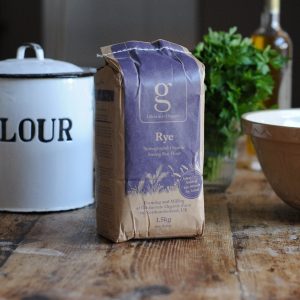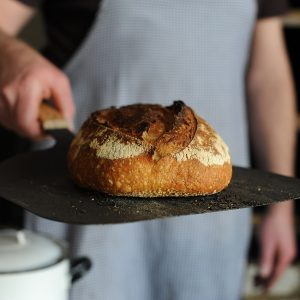500g oval cane banneton
Bannetons or proving baskets are used to support the dough while it rises and just before it goes into the oven to bake it is tipped out and usually scored using a tool called a grignette (a handled lame or blade) to control how the finished bread looks as it expands in the oven.
A new banetton is effectively green and until you have conditioned your new banneton it is not ready for use.
Cane bannetons work best with a thin build-up of flour and moisture. If you have a moment to look in any normal bakery you will see that all bakers value a small build up of flour on their proving baskets. It is the build up of flour and moisture which helps your dough leave the banneton cleanly before baking.
Conditioning a banneton.
After three regular uses you can expect that the banneton has perfect moisture levels to retain a dusting of flour and this facilitates easy release of your dough.
The first time you use your new banneton you can help to condition it by lightly misting it with water. Then dust your banneton with flour and tip out the excess. Do this the day before you use it. This is the beginning of your flour and moisture build up.
When it comes to using your banneton everyday you need to liberally dust it. Ideally the flour will get into the cracks between the cane, but be careful not to over do it. Too much flour will stop the lovely spiral effect your banneton creates. On the other hand you do have to have a good even coverage because equally you don’t want your dough to stick.
Once you have been using your banneton for a few weeks  you will find the right balance .
Which flour to use?
There are several views on which flour to use, but really it depends on what finish you want your bread to have. Some people swear by rye flour. It absorbs moisture well and gives your bread a good crust. For beginners I suggest making up a 50:50 mix of rice flour and stoneground white. It makes it easy for the dough to come out of the basket and leaves a beautiful clean white pattern.
Proving.
The way in which a banneton works is by creating a very slightly humid micro-climate between the dough and the banneton during proving. The banneton holds most of the dough, but the top of the dough is exposed and you must protect your dough from drafts. Generally I use a shower cap, but a dusting of flour and either a light cotton or soft linen cloth will also to the job. Again a build up of flour is also a good thing on your cloth.
Maintaining.
After use leave your banneton in the sunlight for a few hours.  Brush with a dedicated bristle brush and store in a light, well ventilated spot.
An Oblong Cane Banneton is also available, if you prefer the more angular shape.





